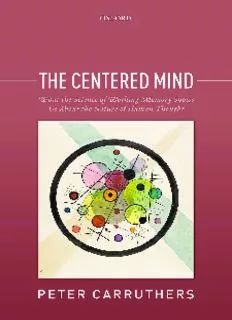
The Centered Mind: What the Science of Working Memory Shows Us About the Nature of Human Thought PDF
Preview The Centered Mind: What the Science of Working Memory Shows Us About the Nature of Human Thought
The Centered Mind The Centered Mind offers a new view of the nature and causal determinants of both reflective thinking and, more generally, the stream of consciousness. Peter Carruthersarguesthatconsciousthoughtisalwayssensory-based,relyingonthe resourcesoftheworking-memorysystem.Thissystemhasbeenmuchstudiedby cognitive scientists. It enables sensory images to be sustained and manipulated throughattentionalsignalsdirectedatmidlevelsensoryareasofthebrain.When abstractconceptualrepresentationsareboundintotheseimages,weconsciously experience ourselves as making judgments or arriving at decisions. Thus one might hear oneself as judging, in inner speech, that it is time to go home, for example. However, our amodal (non-sensory) propositional attitudes are never actually among the contents of this stream of conscious reflection. Our beliefs, goals, and decisions are only ever active in the background of consciousness, working behind the scenes to select the sensory-based imagery that occurs in workingmemory.Theyareneverthemselvesconscious. Drawingonextensiveknowledgeofthescientificliteratureonworkingmem- oryandrelatedtopics,Carruthersbuildsanargumentthatchallengesthecentral assumptions of many philosophers. In addition to arguing that non-sensory propositional attitudes are never conscious, he also shows that they are never under direct intentional control. Written with his usual clarity and directness, The Centered Mind will be essential reading for all philosophers and cognitive scientistsinterestedinthenatureofhumanthoughtprocesses. The Centered Mind What the Science of Working Memory Shows Us About the Nature of Human Thought Peter Carruthers 1 3 GreatClarendonStreet,Oxford,OX26DP, UnitedKingdom OxfordUniversityPressisadepartmentoftheUniversityofOxford. ItfurtherstheUniversity’sobjectiveofexcellenceinresearch,scholarship, andeducationbypublishingworldwide.Oxfordisaregisteredtrademarkof OxfordUniversityPressintheUKandincertainothercountries #PeterCarruthers2015 Themoralrightsoftheauthorhavebeenasserted FirstEditionpublishedin2015 Impression:1 Allrightsreserved.Nopartofthispublicationmaybereproduced,storedin aretrievalsystem,ortransmitted,inanyformorbyanymeans,withoutthe priorpermissioninwritingofOxfordUniversityPress,orasexpresslypermitted bylaw,bylicenceorundertermsagreedwiththeappropriatereprographics rightsorganization.Enquiriesconcerningreproductionoutsidethescopeofthe aboveshouldbesenttotheRightsDepartment,OxfordUniversityPress,atthe addressabove Youmustnotcirculatethisworkinanyotherform andyoumustimposethissameconditiononanyacquirer PublishedintheUnitedStatesofAmericabyOxfordUniversityPress 198MadisonAvenue,NewYork,NY10016,UnitedStatesofAmerica BritishLibraryCataloguinginPublicationData Dataavailable LibraryofCongressControlNumber:2014960130 ISBN 978–0–19–873882–4 Printedandboundby CPIGroup(UK)Ltd,Croydon,CR04YY LinkstothirdpartywebsitesareprovidedbyOxfordingoodfaithand forinformationonly.Oxforddisclaimsanyresponsibilityforthematerials containedinanythirdpartywebsitereferencedinthiswork. OUPCORRECTEDPROOF–FINAL,7/5/2015,SPi for Daniel Dennett —whose work awoke me from my Wittgensteinian slumber— Contents Preface ix Figures xi 1. Introduction 1 1. OnReflection 1 2. TheImportanceoftheIssues 9 3. WorkingMemory 12 4. TheSensory-BasedAccount 14 5. TheRoadAhead 15 6. Conclusion 18 2. PropositionalAttitudes 19 1. BeliefsandDesires 19 2. Goals,Decisions,andIntentions 24 3. ActiveversusPassive:AProblem 27 4. TheCaseforAmodalAttitudes 31 5. TheCaseforStructuredAttitudes 39 6. Conclusion 44 3. Perception,Attention,andConsciousness 46 1. KindsofConsciousness 46 2. GlobalBroadcasting 51 3. ConsciousnessandAttention 54 4. TheNatureofAttention 58 5. AmodalContentinPerception 64 6. Conclusion 73 4. TheNatureofWorkingMemory 75 1. WorkingMemory,Imagery,andPerception 75 2. WorkingMemoryandConsciousness 82 3. WorkingMemoryandAttention 88 4. MentalRehearsal 92 5. TheSensoryBasisofWorkingMemory 100 6. Conclusion 107 5. TheUnityofWorkingMemory 108 1. AnAmodalWorkspace? 108 2. TheProblemofSelf-Knowledge 112 3. TheImportanceofWorkingMemory 118 4. TheCaseoftheMissingVariance 124 OUPCORRECTEDPROOF–FINAL,7/5/2015,SPi viii contents 5. TheDefaultNetwork 134 6. Conclusion 138 6. WorkingMemoryinAction 139 1. UnconsciousGoalPursuit 139 2. AttentionasAction 142 3. MentalRehearsalandMentalManipulation 152 4. GeneratingInnerSpeech 161 5. CreativityandMindWandering 166 6. Conclusion 172 7. Reasoning,WorkingMemory,andAttitudes 174 1. DualSystemsofReasoning 174 2. HowSystem2ReasoningWorks 182 3. System2ReasoninginAction 185 4. ASecondMind? 191 5. AnExtendedMind? 197 6. Conclusion 202 8. TheEvolutionofReflection 203 1. TheCentralPuzzle 203 2. TheAgeofAttention 207 3. EpisodicMemoryandProspectioninBirds 211 4. WorkingMemoryinMammals 216 5. EvolutionaryDevelopmentsacrossSpecies? 223 6. Conclusion 228 9. Conclusion:TheConsciousMindasMarionette 229 1. AgainsttheIntuitiveView 229 2. ThePositivePicture 232 3. ImplicationsforPhilosophyandFutureQuestions 234 4. Conclusion 241 References 243 IndexofNames 275 IndexofSubjects 288 Preface Theprojectofthisbookdevelopedoutofanaspectofmylastone.InTheOpacity ofMind(Carruthers,2011a),Idefendedtheclaimthatourknowledgeofourown thoughts (our beliefs, goals, decisions, and intentions) is always indirect and interpretive, no different in principle from our access to the thoughts of other people. In order to know our own minds, I argued, we have to turn our mind- readingcapacitiesonourselves,drawinginferencesfromsensorilyaccessiblecues (including not only our own overt behavior and circumstances, but also such thingsasourowninnerspeechandvisualimagery).Iarguedthatthisaccountis supported by a wide range of data from across cognitive science. But I also critiqued a number of competing theories proposed by philosophers. One account that I considered briefly is that we have a special-purpose working- memorysystemthatenablesourthoughtstobeconsciousandwidelyavailableto many different faculties of the mind. Since the latter include the mindreading system,wearetherebygivendirectaccesstothenatureandoccurrenceofthose thoughts—our judgments, goals, decisions, and the rest. It only occurred to me later that views similar to this one are quite widespread in philosophy (albeit using different terminology), as well as having considerable intuitive appeal. Moreover, what is really at stake in this aspect of the debate goes well beyond the topic of self-knowledge. Rather, it concerns the very nature of the cognitive architecture that underlies conscious thinking and reasoning, as well as our explanationoftheso-called“streamofconsciousness”moregenerally.Inconse- quence,thetopicisimportantenoughtobeworthyofabookinitsownright. Irelyonanextensivescientificliteratureonworkingmemoryandsurrounding issuestomakemycase.1Sinceworkingmemoryisthecognitivesystemthatwe employwhenweengageinconsciousformsofthinkingandreasoning,andsince (I shall argue) the contents of working memory are always sensory based (depending upon visual, auditory, and other forms of sensory imagery), it seemstofollowthatconsciousthinking,too,issensorybased.Inthatcasenon- sensory(or“amodal”)thoughts(includinggoals,decisions,intentions,andmany 1 Thecontentsofworkingmemoryaregenerallybelievedtobeconscious,drawingfrommany differentunconsciousregionsofthemind.Moreover,thosecontentsarelikewisemadeavailableto many different unconscious mental systems that consume and respond to them. So working memoryis,asitwere,theplacewhere“everythingcomestogether”inthemind.Hencemytitle, TheCenteredMind.
Description: